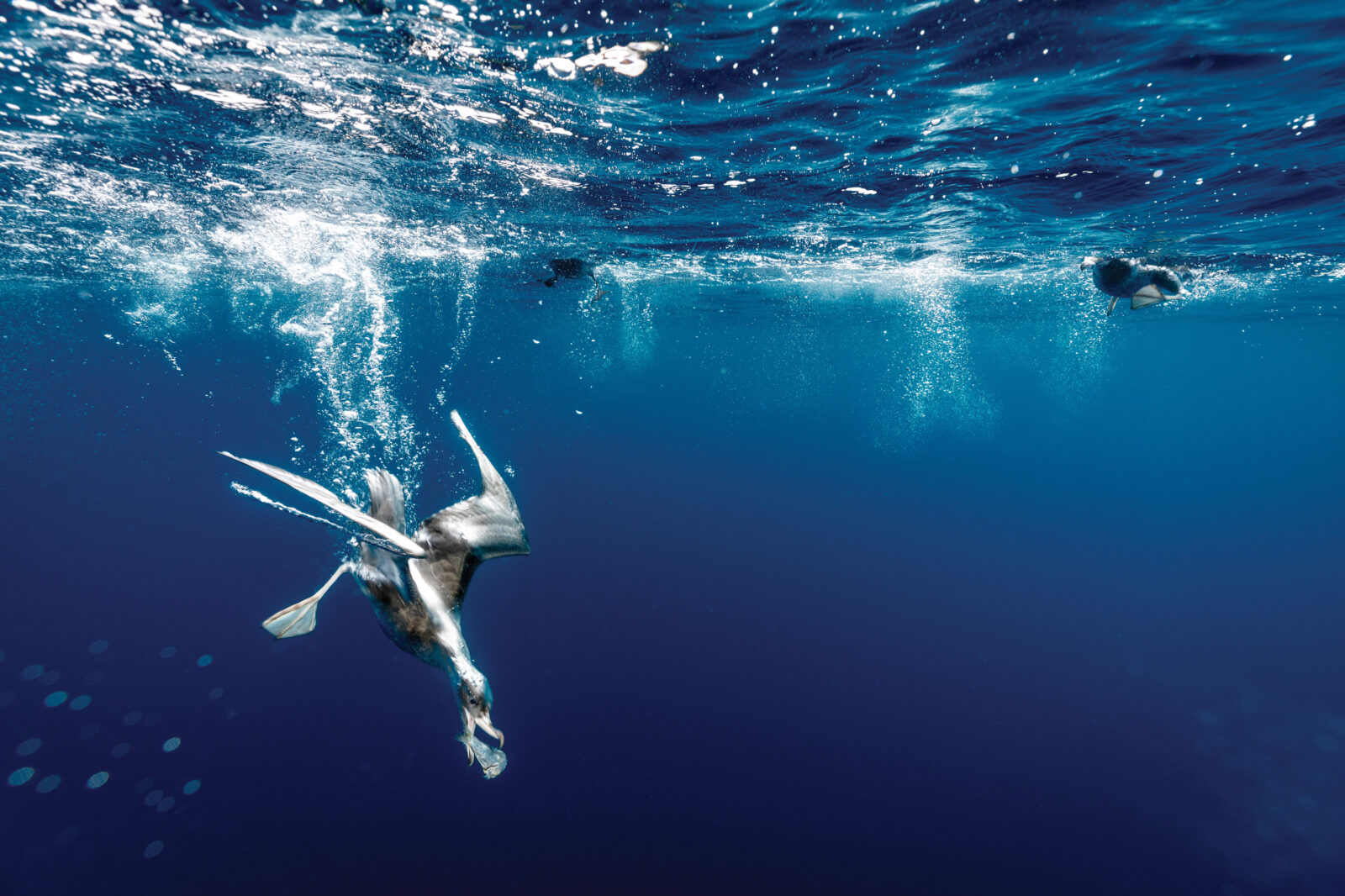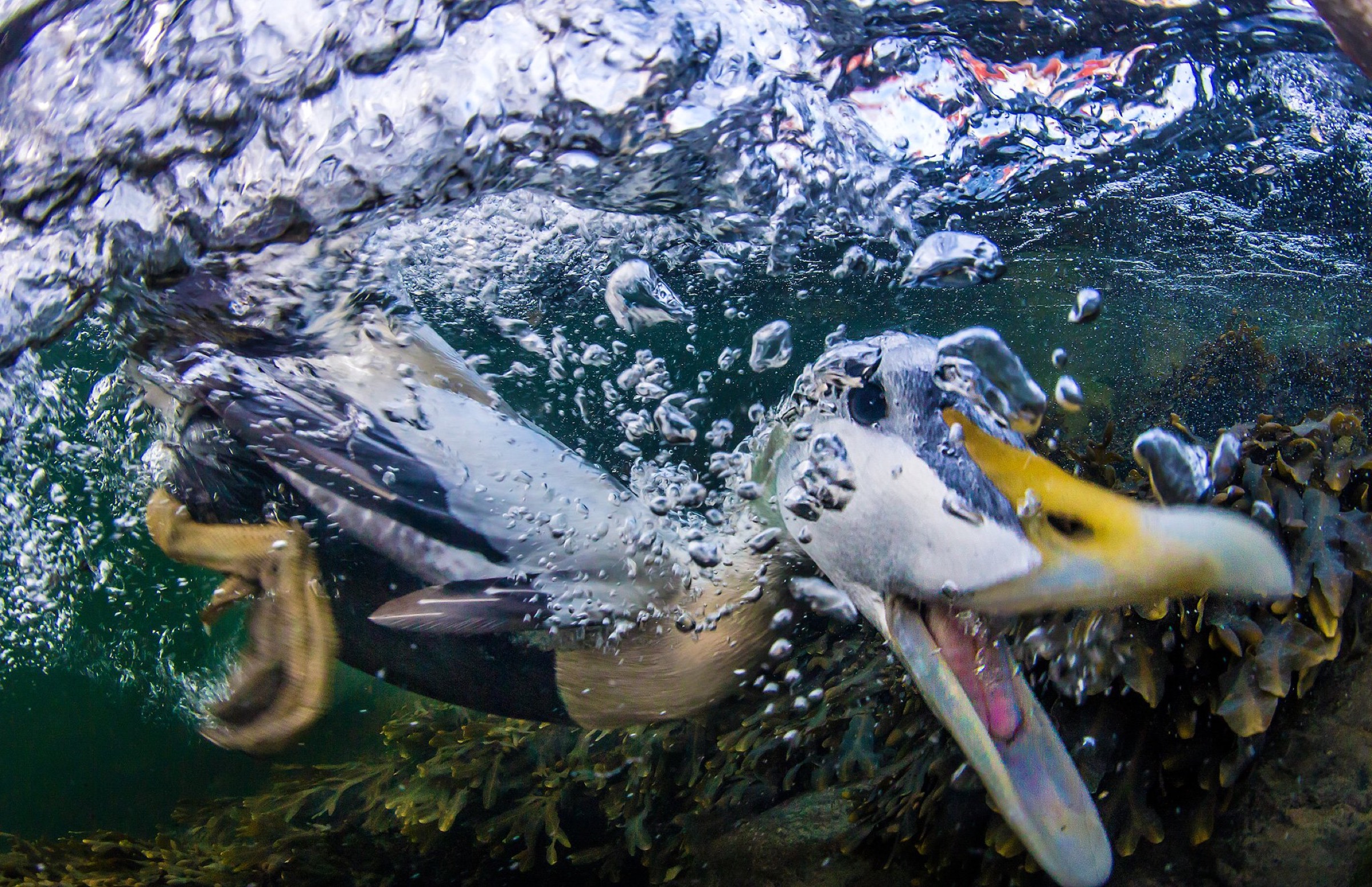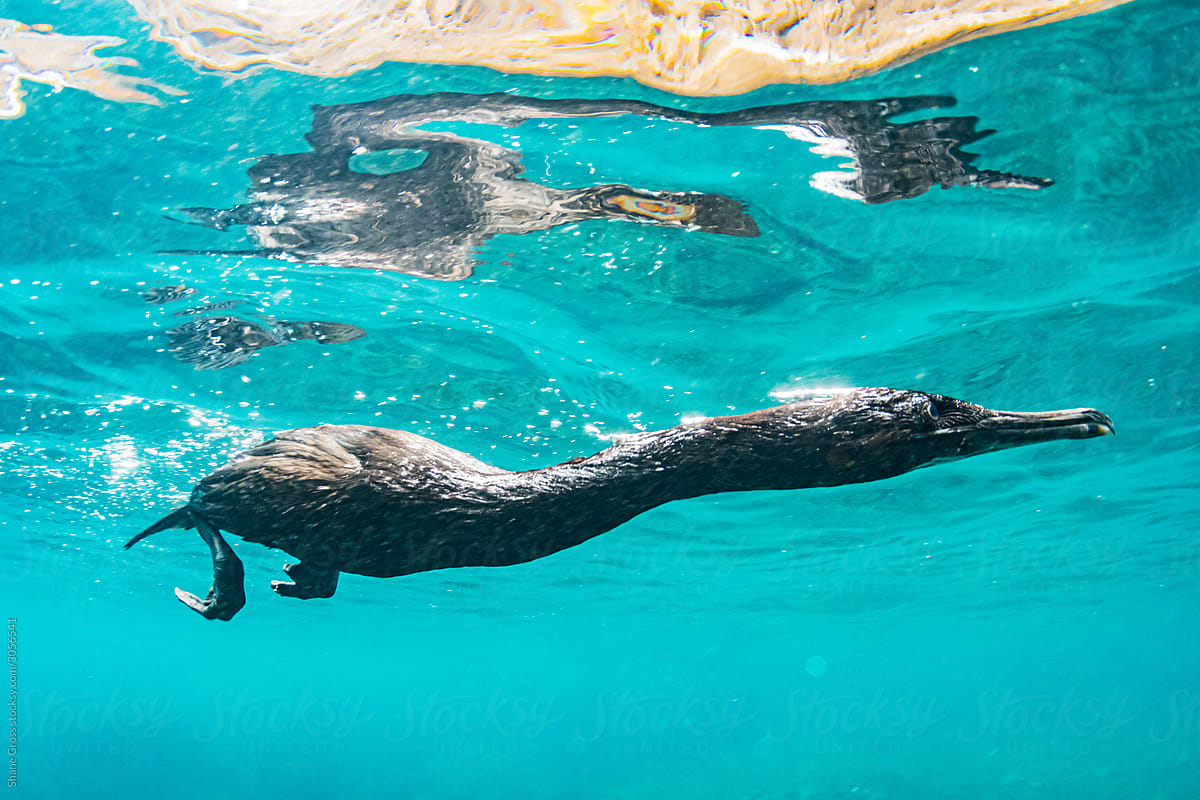Birds are known for their ability to fly, but did you know that some birds can also swim and dive underwater? These birds are known as aquatic birds or waterbirds and are typically found in freshwater environments like lakes, rivers, and streams, as well as in the ocean.
They have special adaptations that allow them to seamlessly glide through the water, making them fascinating creatures to observe in their natural habitats.
You are reading: Discover Types Of Birds That Can Swim Underwater
These birds have a diet rich in fish, mollusks, and other sea creatures, and they have adaptations that let them submerge themselves in oceans and freshwater bodies.
In this article, we will discover 11 types of birds that can swim underwater and learn about their aquatic adaptations.

11 Types Of Birds That Can Swim Underwater
Ducks

Ducks are a type of bird that are known for their ability to swim and dive underwater. They have webbed feet that help them paddle through the water, and they can hold their breath for several minutes while diving. While dabbling ducks rarely dive underwater, diving ducks are capable of some impressive dives, holding their breath for around 10 to 30 seconds.
Some species of ducks that can swim underwater include:
– Stifftail: Stifftail ducks are small, diving ducks that are found in North America. They are known for their ability to swim and dive underwater to catch fish and other aquatic prey.
– Eiders: Eiders are large, sea ducks that are found in the northern hemisphere. They are skilled divers and can swim underwater for several seconds to catch fish and mollusks.
– Scoters: Scoters are diving ducks that are found in the northern hemisphere. They are known for their ability to dive deep underwater to catch fish and other prey.
– Merganser: Mergansers are diving ducks that are found in North America and Europe. They have long, slender bills that help them catch fish underwater, and they can hold their breath for up to a minute while diving.
– Goldeneyes: Goldeneyes are diving ducks that are found in North America and Europe. They are skilled swimmers and divers, and they can hold their breath for up to a minute while diving.
– Bufflehead: Buffleheads are small, diving ducks that are found in North America. They are known for their ability to swim and dive underwater to catch fish and other aquatic prey.
– Long-tailed duck: Long-tailed ducks are sea ducks that are found in the northern hemisphere. They are skilled divers and can swim underwater for several seconds to catch fish and mollusks.
– Canvasbacks: Canvasbacks are diving ducks that are found in North America. They have long, narrow bills that help them catch fish underwater, and they can hold their breath for up to a minute while diving.
Ducks are fascinating creatures to observe in their natural habitats, and their ability to swim and dive underwater is just one of the many adaptations that make them unique.
Cormorants

Cormorants are a type of aquatic bird known for their remarkable diving abilities. They are excellent swimmers and can remain underwater for several minutes at a time, swimming to depths of up to 150 feet.
Cormorants have long, streamlined bodies and webbed feet, which make them powerful swimmers and divers. They have waterproof plumage and special glands near their eyes that secrete an oily substance, which helps to keep their feathers waterproof. This adaptation allows them to spend long periods of time underwater in pursuit of fish, their primary food.
Cormorants swim by paddling with both feet simultaneously in a gait that includes long glides between consecutive strokes. They are also known for their submerged swimming technique, which is a variant of the burst-and-glide gait.
Cormorants and shags belong to the Phalacrocoracidae family, spanning three genera, and consisting of nearly forty individual species. These water birds have small, streamlined heads with long, thin, hooked bills, and relatively short wings, which is advantageous for their underwater diving habits, but less useful for flight.
Cormorants and shags feed primarily on fish, but they also prey on aquatic invertebrates such as crustaceans, eels, and water snakes.
Loons
Read more : Can Cockatiels Eat Almonds?
Loons, also known as divers, are a group of aquatic birds found in much of North America and northern Eurasia. They are the size of large ducks or small geese and resemble these birds in shape when swimming. Like ducks and geese, but unlike coots and grebes, the loon’s toes are connected by webbing.
Loons are excellent swimmers, using their feet to propel themselves above and under water. However, since their feet are located far back on the body, loons have difficulty walking on land, though they can effectively run short distances to reach water when frightened. Thus, loons avoid coming to land, except for mating and nesting.
Loons nest during the summer on freshwater lakes and/or large ponds. Smaller bodies of water will usually only have one pair, while larger lakes may have more than one pair, with each pair occupying a bay or section of the lake. The red-throated loon, however, may nest colonially, several pairs together.
Loons are agile swimmers, but they move pretty fast in the air, too. Migrating loons have been clocked flying at speeds more than 70 mph. A hungry loon family can put away a lot of fish. Biologists estimate that loon parents and their 2 chicks can eat about a half-ton of fish over a 15-week period.
Pelicans
Pelicans are a type of bird that are known for their distinctive pouches, which they use to scoop up fish while swimming. They are also capable of diving underwater to catch fish.
Pelicans are surface hunters, not divers, but they can dive from the surface and swim underwater to find food like small fish. They catch their prey by driving it to the surface and then grabbing it with their bills.
Pelicans are capable of diving from ten to thirty feet in the air, but can dive from as high as 100 feet. When they hit the water, they do so at breakneck speed, but they have several adaptations that protect them from injury.
Air sacs beneath the skin on their breasts act like cushions, and while diving, a pelican rotates its body ever so slightly to the left to avoid injury to the esophagus and trachea, which are located on the right side of the bird’s neck.
Pelicans have also learned that a steep dive angle, between 60 and 90 degrees, reduces aiming errors caused by water surface refraction. Upon impact, the Brown Pelican opens its bill and expands its pouch.
Penguins
Penguins are a family of aquatic birds that live primarily in the Southern Hemisphere. They are flightless birds that have flippers instead of wings, which they use to swim and dive underwater.
Penguins are expert swimmers and divers, and some species can reach speeds of up to 15 miles per hour. They have a distinctive black and white coloring that helps camouflage them in the water as they search for meals of small shrimp, fish, crabs, and squid.
Penguins come in different sizes, with the smallest being the little blue penguin, which is only about 16 inches tall, while the largest is the emperor penguin, which can grow up to 4 feet tall.
Penguins are also known for their upright, waddling gait on land, and they tend to slide on their bellies when snow conditions are right. Penguins are fascinating creatures that have captured the attention of people around the world, and they are the subject of many documentaries and films.
However, it is important to note that there is also a professional ice hockey team called the Pittsburgh Penguins, which competes in the National Hockey League (NHL).
Puffins
Puffins are a type of bird that are known for their colorful beaks and comical appearance. They are also skilled swimmers and divers, using their wings to essentially “fly” underwater while using their feet to control direction.
Puffins are excellent divers and can reach depths of up to 200 feet while searching for food. They hunt a variety of small fish, including herring, hake, capelin, and sand lance. Puffins are also known to “fly” underwater at the Monterey Bay Aquarium, where their short wings are adapted for swimming with a flying technique under water.
There are even opportunities to snorkel with puffins in Pembrokeshire, UK, where they are considered one of the most photogenic birds.
Overall, puffins are fascinating creatures that are well adapted to their life at sea, and their underwater swimming abilities are just one of the many adaptations that make them unique.
Coots
Coots are medium-sized water birds that are members of the rail family, Rallidae, and they constitute the genus Fulica, the name being the Latin term for “coot”. They have predominantly black plumage and are usually easy to see, often swimming in open water.
Coots have prominent frontal shields or other decoration on the forehead, with red to dark red eyes and colored bills. They have long, lobed toes that are well adapted to soft, uneven surfaces, and they have strong legs that allow them to walk and run vigorously.
Coots are omnivorous, eating mainly plant material, but also small animals, fish, and eggs. Although they are related to the secretive rails, they swim in the open like ducks and walk about on shore, making them tough, adaptable waterbirds.
The American coot is a migratory bird that occupies most of North America, living in the Pacific and southwestern United States and Mexico year-round and occupying more northeastern regions during the summer breeding season.
Unlike the webbed feet of ducks, coots have broad, lobed scales on their lower legs and toes that fold back with each step, which facilitates walking on dry land. Coots live near water, typically inhabiting wetlands and open water bodies in North America.
Grebes
Read more : Can Parrots Eat Radishes
Grebes are a type of aquatic bird that are known for their excellent swimming and diving abilities. They have lobed toes that help them paddle through the water, and they are capable of swimming and diving underwater to catch fish and other aquatic prey.
Grebes are also known for their unique swimming style, which involves using their feet to propel themselves forward while holding their wings close to their bodies. They can hold their breath for up to a minute while diving, and they are capable of reaching depths of up to 20 feet.
Grebes are found in freshwater environments like lakes, ponds, and rivers, and they are distributed throughout much of the world. They are fascinating creatures to observe in their natural habitats, and their underwater swimming abilities are just one of the many adaptations that make them unique.
Anhingas
Anhingas, also known as snakebirds, darters, American darters, or water turkeys, are a type of water bird found in the warmer parts of the Americas. They are found all over the world in warm shallow waters.
Anhingas are large birds, measuring approximately 89 cm (35 in) in length, with a 1.14 m (3.7 ft) wingspan. They have a long S-shaped neck and a dagger-like bill.
Anhingas are excellent swimmers and divers, using their long necks to slither through the water in search of fish and other aquatic prey. They have webbed feet that are not fully webbed, which helps them move through the water more easily.
Unlike most waterbirds, anhingas do not have waterproof feathers, but their wet feathers and dense bones help them slowly submerge their bodies under the water so they can slyly stalk their prey.
Anhingas are fascinating creatures to observe in their natural habitats, and their underwater swimming abilities are just one of the many adaptations that make them unique.
Auks & Auklets
Auks and auklets are a family of aquatic birds that are adapted to swimming and diving, with dense, waterproof feathers to help them stay warm and dry in cold ocean waters. They have webbed feet that help them speed through the water, chasing after their prey of fish and small marine animals.
Auks are larger, with straight, pointed bills for catching fish, while auklets are smaller birds with shorter and thicker bills that have a more rounded tip that helps them catch small prey like krill and copepods.
Both auks and auklets are adapted to living in cold, open water environments and are able to dive to great depths in search of food. They typically breed in large colonies on rocky islands or cliffs near the coast, where they can find suitable nesting sites and access to the ocean for feeding.
Although not to the extent of penguins, auks have largely sacrificed flight and mobility on land in exchange for swimming ability. Their wings are a compromise between the best possible design for diving and the bare minimum needed for flying.
Their webbed feet, which are stretched out during swimming, act as a rudder and help them change or maintain direction. Some species have been known to reach depths as great as 600 feet while diving.
Dippers
Dippers are a type of songbird that are unique among passerines for their ability to dive and swim underwater. They are also known as American dippers and are found in North America.
Dippers have a stocky, grey body with powerful wings that allow them to swim against the current, while their strong toes help them to hunt aquatic insects and fish eggs hiding beneath stones and wood. They have a thick coat of waterproof feathers that insulates them from chilly waters, and their blood carries extra oxygen, which helps them stay submerged.
Dippers employ a variety of foraging strategies, including walking along the water’s edge, standing on a rock in the middle of the stream and dunking their head into the depths, diving underwater or beneath ice, and walking along the stream bottom in search of prey.
They are not shy birds and are often seen by people on paths. Overall, dippers are fascinating creatures that are well adapted to their life in and around water, and their underwater swimming abilities are just one of the many adaptations that make them unique.
FAQS
1. What are some types of birds that can swim underwater?
Some types of birds that can swim underwater include ducks, loons, cormorants, pelicans, penguins, puffins, coots, grebes, anhingas, auks, auklets, and dippers.
2. How do birds swim underwater?
Birds swim underwater using a variety of techniques, including using their wings to “fly” through the water, using their feet to paddle, and holding their breath while diving.
3. What adaptations do birds that swim underwater have?
Birds that swim underwater have a variety of adaptations that help them survive in aquatic environments, including waterproof feathers, webbed feet, and the ability to hold their breath for extended periods of time.
4. Can all birds swim underwater?
No, not all birds can swim underwater. However, many aquatic birds have adapted to life in the water and are skilled swimmers and divers.
5. What is the difference between diving birds and swimming birds?
Diving birds are birds that are adapted to diving deep underwater to catch fish and other prey, while swimming birds are birds that are adapted to swimming on the surface of the water or just below the surface.
6. What are some interesting facts about birds that can swim underwater?
Some interesting facts about birds that can swim underwater include that penguins can reach speeds of up to 15 miles per hour while swimming, and that anhingas do not have waterproof feathers but instead have dense bones that help them stay submerged.
Source: https://petstutorial.com
Category: Birds










